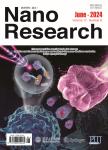Surface-enhanced Raman scattering nanosensors for in vivo detection of nucleic acid targets in a large animal model
Surface-enhanced Raman scattering nanosensors for in vivo detection of nucleic acid targets in a large animal model作者机构:Departments of Biomedical Engineering Duke University Durham NC27708 USA Fitzpatrick Institute for Photonics Duke University Durham NC27708 USA Medical Center Duke University Durham NC27710 USA Deportments of Chemistry Duke University Durham NC27708 USA Hsin-Neng Wang Janna K. Register and Andrew M. Fales contributed equally to this work.
出 版 物:《Nano Research》 (纳米研究(英文版))
年 卷 期:2018年第11卷第8期
页 面:4005-4016页
核心收录:
学科分类:0808[工学-电气工程] 06[历史学] 0809[工学-电子科学与技术(可授工学、理学学位)] 060207[历史学-专门史] 07[理学] 08[工学] 0805[工学-材料科学与工程(可授工学、理学学位)] 0602[历史学-中国史] 0712[理学-科学技术史(分学科,可授理学、工学、农学、医学学位)] 081201[工学-计算机系统结构] 0702[理学-物理学] 0812[工学-计算机科学与技术(可授工学、理学学位)]
基 金:sponsored by the Defense Advanced Research Projects Agency
主 题:nanosensor nanoprobes plasmonics nanostar surface-enhanced Ramanscattering (SERS) in vivo sensing
摘 要:Although nanotechnology has led to important advances in in vitro diagnostics, the development of nanosensors for in vivo detection remains very challenging. Here, we demonstrated the proof-of-principle of in vivo detection of nudeic acid targets using a promising type of surface-enhanced Raman scattering (SERS) nanosensor implanted in the skin of a large animal model (pig). The in vivo nanosensor used in this study involves the "inverse molecular sentinel" detection scheme using plasmonics-active nanostars, which have tunable absorption bands in the near infrared region of the "tissue optical window", rendering them efficient as an optical sensing platform for in vivo optical detection. Ex vivo measurements were also performed using human skin grafts to demonstrate the detection of SERS nanosensors through tissue. In this stud, a new core--shell nanorattle probe with Raman reporters trapped between the core and shell was utilized as an internal standard system for self-calibration. These results illustrate the usefulness and translational potential of the SERS nanosensor for in vivo biosensing.



